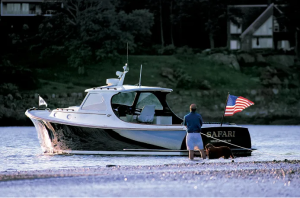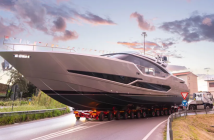The late-morning fog had just lifted when I climbed on board Dasher, the just-launched hull number one of the Hinckley Picnic boat with Shep McKenney, the chairman of the company. A few lobster boats passed by the Hinckley dock in Southwest Harbor, Maine, as we cast off; he said their lines had inspired his idea for the boat.
The Picnic Boat was a gamble for Hinckley. The company was suffering from the lasting effects of the 1990 luxury tax, which had decimated the recreational boating industry in the U.S. And the sailboat market, which had been Hinckley’s main business since it was founded in 1928, was tanking, the result of societal changes way beyond Hinckley’s control.
Sailing took time, which was becoming a precious commodity for American families at the end of the 20th Century. McKenney knew that Hinckley owners reported they were often using their cruising sailboats as day boats, powering through the water for an afternoon afloat, rather than actually sailing.
He had solicited renderings for an entirely new Hinckley, a day powerboat, from three yacht designers. And he said he wanted a beautiful boat, as well. The first two weren’t right. But when he opened the third, from Bruce King, he knew he had the answer. The Hinckley Picnic Boat, a 36-foot day boat with a single diesel, low draft, and Hamilton waterjet drive, was born.

Even at first glance, it was obvious that the Picnic Boat was a winner. For one thing, Dasher was drop-dead gorgeous, with a sweeping sheer, beautiful curves, and a classic tumblehome. Yes, it was reminiscent of a traditional Maine lobster boat, but a lobster boat that was the result of a mixed marriage with a Riva.
And it performed. As we headed up Somes Sound, I put Dasher into some turns, and the jet drive powered some head-snapping maneuvering. It was fast and fun, really fun. And although there are no beaches on Somes Sound (it’s a type of fjord), it was clear that with Dasher’s low draft you could run it up on a beach for a picnic if you wanted, or maneuver through skinny water in the Chesapeake or the Bahamas, or just enjoy water sports without worrying about the inherent dangers of a propeller.
But there was a problem. When we returned to the dock, it was apparent that docking a single-jet boat was counter-intuitive, to say the least. McKenney realized that it was an issue. He went back to the drawing board, and before long came up with the solution: Hinckley’s patented JetStick, which made docking and low-speed maneuvering fingertip easy.
As we all know, the Picnic Boat took off. Its iconic lines were recognized, and copied, around the world. (Years later, when my wife and I were on a new Picnic Boat on Italy’s Lake Como, the owner of the waterfront restaurant where we tied up for lunch asked if we could leave it there, for free, overnight; it was so beautiful.)
The Picnic Boat was a huge financial success, as well. To date, Hinckley has sold more than 1,200 of them.
Hinckley is now celebrating the Picnic Boat’s 30th anniversary, and it has launched the Picnic Boat Signature Edition, including the Picnic Boat 37 (pictured, with dog) and Picnic Boat 40. They’ve come a long way from Dasher. The lines are still the same, but the hulls are laid up with state-of-the-art technology that includes carbon fiber and epoxy. And the 40 comes with Hinckley’s new SilentJet technology, starting with silent power for cruising through a mooring field, before switching to diesel.
The changes, and the improvements, are all well and good. But the basic fact remains. Shep McKenney wanted a beautiful boat. He got one.
Read more at https://www.hinckleyyachts.com/our-story/ and see a video of the Picnic Boat’s 25th anniversary below:




